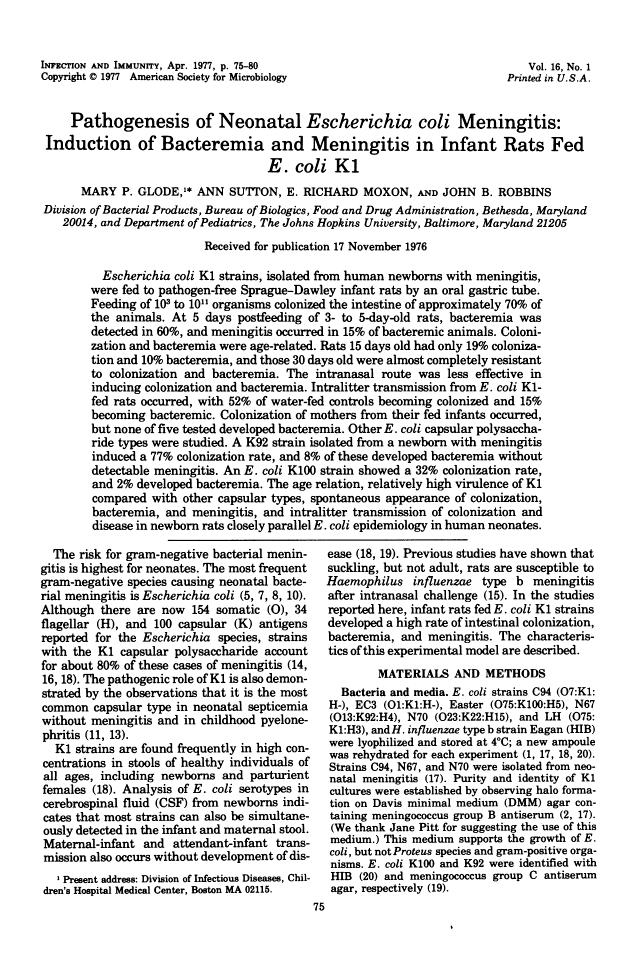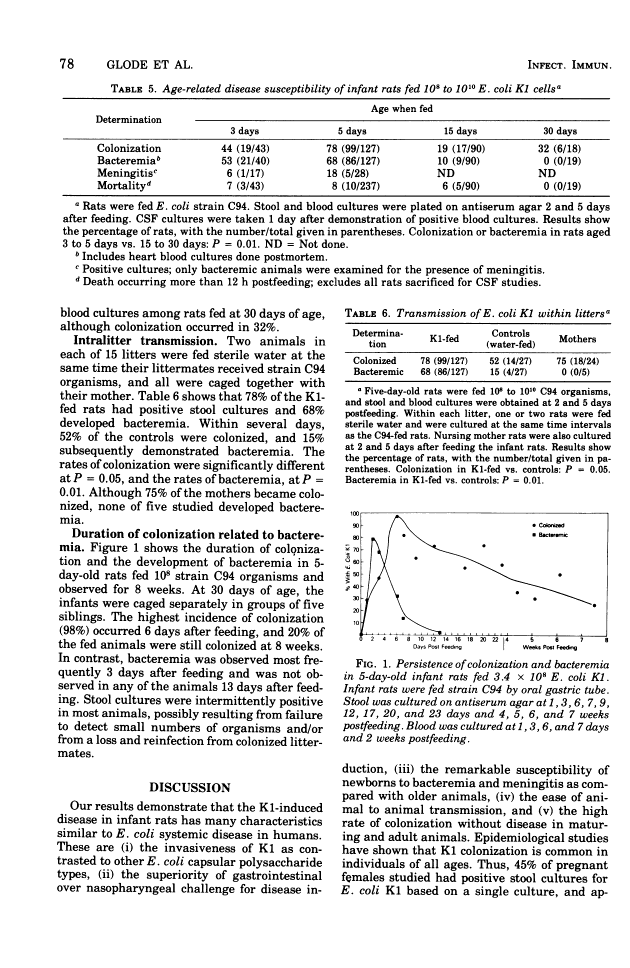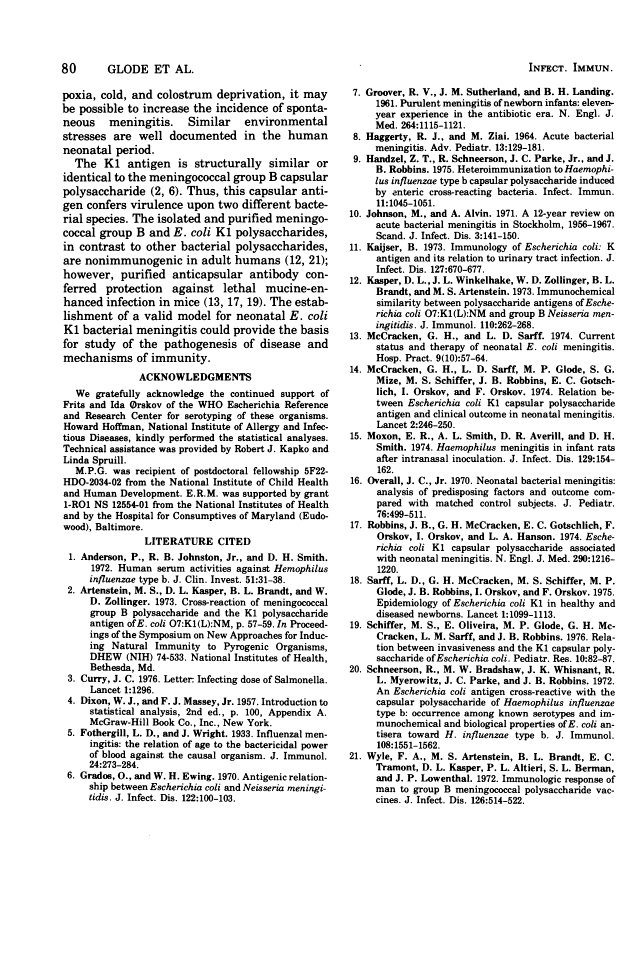Abstract
Free full text

Pathogenesis of neonatal Escherichia coli meningitis: induction of bacteremia and meningitis in infant rats fed E. coli K1.
Abstract
Escherichia coli K1 strains, isolated from human newborns with meningitis, were fed to pathogen-free Sprague-Dawley infant rats by an oral gastric tube. Feeding of 10(3) to 10(11) organisms colonized the intestine of approximately 70% of the animals. At 5 days postfeeding of 3- to 5-day-old rats, bacteremia was detected in 60%, and meningitis occurred in 15% of bacteremic animals. Colonization and bacteremia were age-related. Rats 15 days old had only 19 colonization and 10% bacteremia, and those 30 days old were almost completely resistant to colonization and bacteremia. The intranasal route was less effective in inducing colonization and bacteremia. Intralitter transmission from E. coli K1-fed rats occurred, with 52% of water-fed controls becoming colonized and 15% become bacteremic. Colonization of mothers from their fed infants occurred, but none of five tested developed bacteremia. Other E. coli capsular polysaccharide types were studied. A K92 strain isolated from a newborn with meningitis induced a 77% colonization rate, and 8% of these developed bacteremia without detectable meningitis. An E. coli K100 strain showed a 32% colonization rate, and 2% developed bacteremia. The age relation, relatively high virulence of K1 compared with other capsular types, spontaneous appearance of colonization, bacteremia, and meningitis, and intralitter transmission of colonization and disease in newborn rats closely parellel E. coli epidemiology in human neonates.
Full text
Full text is available as a scanned copy of the original print version. Get a printable copy (PDF file) of the complete article (1.0M), or click on a page image below to browse page by page. Links to PubMed are also available for Selected References.
Selected References
These references are in PubMed. This may not be the complete list of references from this article.
- Anderson P, Johnston RB, Jr, Smith DH. Human serum activities against Hemophilus influenzae, type b. J Clin Invest. 1972 Jan;51(1):31–38. [Europe PMC free article] [Abstract] [Google Scholar]
- Curry JC. Infecting dose of salmonella. Lancet. 1976 Jun 12;1(7972):1296–1296. [Abstract] [Google Scholar]
- Grados O, Ewing WH. Antigenic relationship between Escherichia coli and Neisseria meningitidis. J Infect Dis. 1970 Jul-Aug;122(1):100–103. [Abstract] [Google Scholar]
- GROOVER RV, SUTHERLAND JM, LANDING BH. Purulent meningitis of newborn infants. Eleven-year experience in the antibiotic era. N Engl J Med. 1961 Jun 1;264:1115–1121. [Abstract] [Google Scholar]
- HAGGERTY RJ, ZIAI M. ACUTE BACTERIAL MENINGITIS. Adv Pediatr. 1964;13:129–181. [Abstract] [Google Scholar]
- Handzel ZT, Argaman M, Parke JC, Jr, Schneerson R, Robbins JB. Heteroimmunization to the capsular polysaccharide of Haemophilus influenzae type b induced by enteric cross-reacting bacteria. Infect Immun. 1975 May;11(5):1045–1052. [Europe PMC free article] [Abstract] [Google Scholar]
- Jonsson M, Alvin A. A 12-year review of acute bacterial meningitis in Stockholm. Scand J Infect Dis. 1971;3(2):141–150. [Abstract] [Google Scholar]
- Kaijser B. Immunology of Escherichia coli: K antigen and its relation to urinary-tract infection. J Infect Dis. 1973 Jun;127(6):670–677. [Abstract] [Google Scholar]
- Kasper DL, Winkelhake JL, Zollinger WD, Brandt BL, Artenstein MS. Immunochemical similarity between polysaccharide antigens of Escherichia coli 07: K1(L):NM and group B Neisseria meningitidis. J Immunol. 1973 Jan;110(1):262–268. [Abstract] [Google Scholar]
- McCracken GH, Jr, Sarff LD, Glode MP, Mize SG, Schiffer MS, Robbins JB, Gotschlich EC, Orskov I, Orskov F. Relation between Escherichia coli K1 capsular polysaccharide antigen and clinical outcome in neonatal meningitis. Lancet. 1974 Aug 3;2(7875):246–250. [Abstract] [Google Scholar]
- Moxon ER, Smith AL, Averill DR, Smith DH. Haemophilus influenzae meningitis in infant rats after intranasal inoculation. J Infect Dis. 1974 Feb;129(2):154–162. [Abstract] [Google Scholar]
- Overall JC., Jr Neonatal bacterial meningitis. Analysis of predisposing factors and outcome compared with matched control subjects. J Pediatr. 1970 Apr;76(4):499–511. [Abstract] [Google Scholar]
- Robbins JB, McCracken GH, Jr, Gotschlich EC, Orskov F, Orskov I, Hanson LA. Escherichia coli K1 capsular polysaccharide associated with neonatal meningitis. N Engl J Med. 1974 May 30;290(22):1216–1220. [Abstract] [Google Scholar]
- Sarff LD, McCracken GH, Schiffer MS, Glode MP, Robbins JB, Orskov I, Orskov F. Epidemiology of Escherichia coli K1 in healthy and diseased newborns. Lancet. 1975 May 17;1(7916):1099–1104. [Abstract] [Google Scholar]
- Schiffer MS, Oliveira E, Glode MP, McCracken GH, Jr, Sarff LM, Robbins JB. A review: relation between invasiveness and the K1 capsular polysaccharide of Escherichia coli. Pediatr Res. 1976 Feb;10(2):82–87. [Abstract] [Google Scholar]
- Schneerson R, Bradshaw M, Whisnant JK, Myerowitz RL, Parke JC, Jr, Robbins JB. An Escherichia coli antigen cross-reactive with the capsular polysaccharide of Haemophilus influenzae type b: occurrence among known serotypes, and immunochemical and biologic properties of E. coli antisera toward H. influenzae type b. J Immunol. 1972 Jun;108(6):1551–1562. [Abstract] [Google Scholar]
- Wyle FA, Artenstein MS, Brandt BL, Tramont EC, Kasper DL, Altieri PL, Berman SL, Lowenthal JP. Immunologic response of man to group B meningococcal polysaccharide vaccines. J Infect Dis. 1972 Nov;126(5):514–521. [Abstract] [Google Scholar]
Associated Data
Articles from Infection and Immunity are provided here courtesy of American Society for Microbiology (ASM)
Full text links
Read article at publisher's site: https://doi.org/10.1128/iai.16.1.75-80.1977
Read article for free, from open access legal sources, via Unpaywall:
https://iai.asm.org/content/iai/16/1/75.full.pdf
Free to read at iai.asm.org
http://iai.asm.org/cgi/content/abstract/16/1/75
Free after 4 months at iai.asm.org
http://iai.asm.org/cgi/reprint/16/1/75
Citations & impact
Impact metrics
Citations of article over time
Article citations
A live attenuated vaccine to prevent severe neonatal Escherichia coli K1 infections.
Nat Commun, 15(1):3021, 08 Apr 2024
Cited by: 2 articles | PMID: 38589401 | PMCID: PMC11001983
Phage Targeting Neonatal Meningitis E. coli K1 In Vitro in the Intestinal Microbiota of Pregnant Donors and Impact on Bacterial Populations.
Int J Mol Sci, 24(13):10580, 24 Jun 2023
Cited by: 1 article | PMID: 37445758 | PMCID: PMC10341584
Loss of Trefoil Factor 2 Sensitizes Rat Pups to Systemic Infection with the Neonatal Pathogen Escherichia coli K1.
Infect Immun, 87(5):e00878-18, 01 Mar 2019
Cited by: 6 articles | PMID: 30833331 | PMCID: PMC6479038
Draft Genome Sequences of Five Neonatal Meningitis-Causing Escherichia coli Isolates (SP-4, SP-5, SP-13, SP-46, and SP-65).
Genome Announc, 6(16):e00091-18, 19 Apr 2018
Cited by: 0 articles | PMID: 29674529 | PMCID: PMC5908952
Genome-Wide Identification by Transposon Insertion Sequencing of Escherichia coli K1 Genes Essential for In Vitro Growth, Gastrointestinal Colonizing Capacity, and Survival in Serum.
J Bacteriol, 200(7):e00698-17, 12 Mar 2018
Cited by: 23 articles | PMID: 29339415 | PMCID: PMC5847654
Go to all (79) article citations
Similar Articles
To arrive at the top five similar articles we use a word-weighted algorithm to compare words from the Title and Abstract of each citation.
The infant rat as a model of bacterial meningitis.
J Infect Dis, 136 Suppl:S186-90, 01 Aug 1977
Cited by: 29 articles | PMID: 330777
Neonatal meningitis due of Escherichia coli K1.
J Infect Dis, 136 Suppl:S93-7, 01 Aug 1977
Cited by: 23 articles | PMID: 330780
Review
ColV increases the virulence of Escherichia coli K1 strains in animal models of neonatal meningitis and urinary infection.
Med Microbiol Immunol, 178(4):211-216, 01 Jan 1989
Cited by: 16 articles | PMID: 2664439
Bioluminescent imaging reveals novel patterns of colonization and invasion in systemic Escherichia coli K1 experimental infection in the neonatal rat.
Infect Immun, 83(12):4528-4540, 08 Sep 2015
Cited by: 22 articles | PMID: 26351276 | PMCID: PMC4645386










